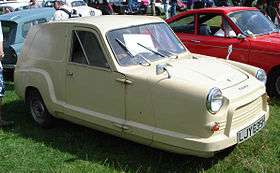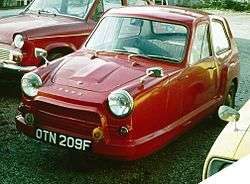Bond 875
The Bond 875 was a small three-wheeled car partly designed by Lawrence "Lawrie" Bond and manufactured by Bond Cars Ltd in Preston, United Kingdom from 1965 to 1970. There was also a van version from 1967, known as the Ranger.
| Bond 875 | |
|---|---|
 1970 Bond 875 Ranger van | |
| Overview | |
| Manufacturer | Bond Cars Ltd |
| Production | 1965-1970 3431 made[1] |
| Assembly | Preston, UK |
| Body and chassis | |
| Class | microcar |
| Body style | 2-door saloon 2-door van |
| Powertrain | |
| Engine | Rootes Commer Imp van, 875 cc, 34 b.h.p. |
| Transmission | 4-speed manual |
| Dimensions | |
| Wheelbase | 78 in (1,981 mm)[2] |
| Length | 116 in (2,946 mm)[2] |
| Width | 55 in (1,397 mm)[2] |
| Chronology | |
| Predecessor | Bond Minicar |
| Successor | Bond Bug |

The car was announced in August 1965, though volume production got under way only during the summer of 1966.[3] The 875 used the lower-compression (8:1) four-cylinder 875 cc 34 b.h.p. four-stroke engine used in the Commer Imp Van from the Rootes Group. Crucially for the dynamics of the vehicle, this was rear-mounted, unlike in most other British three-wheelers of the era. It was the same basic layout as used in the Hillman Imp, installed as a complete package along with the Imps' transmission, rear suspension and rear wheels: however, thanks to the fact that the 875 had a fibreglass body along with aluminium doors, and weighed less than 400 kg (882 lb), the performance was good — better than the Imp. The low-compression engine meant it was able to run on "2-star" low-octane petrol, which was cheaper than varieties used by larger and more highly tuned engines.
The car's light weight enabled it to qualify for motorcycle road tax rates, and be driven on a motorcycle licence but in order to keep the weight down the interior trim and fittings were minimal.
Racing driver John Surtees drove the car at Brands Hatch in 1965, setting a fastest lap of 1:22[4] for the 1.24 mile circuit[5] and attaining speeds over 100 mph (161 km/h).[6] Bond played on the car's sporty reputation, track testing a standard production version around the Silverstone Circuit in 1966, setting a lap time of 1:43.34 and reaching 76 mph (122 km/h) through a timing trap along the Hanger Straight. Following the test, Bond refused to confirm or deny that they would be building a racing version of the car for 1967.[7]
Development
A van version, the Ranger, was introduced in April 1967.
Styling changes, rectangular headlamps, front grille, a larger bonnet opening and revised seats heralded the "Mark II" announced in April 1968.[8] Other changes included the fitting of a heater as standard equipment.[8]
Specification and performance
- Capacity: 875 cc, 34 b.h.p.
- Weight: < 400 kg (882 lb)
- 0-60 mph: 16 seconds (car), 14 seconds (van)
- Top speed: 80 mph (129 km/h) (car), 95 mph (153 km/h) (van)
- Fuel economy: 50 mpg‑imp (5.6 L/100 km; 42 mpg‑US) - 55 mpg‑imp (5.1 L/100 km; 46 mpg‑US)
- Tyres: Michelin X radial
- Price new: £500
Road test
The British Autocar magazine tested a Bond 875 in September 1966. The car had a top speed of 82.8 mph (133.3 km/h) and accelerated from 0-60 mph (97 km/h) in 22.5 seconds. An "overall" fuel consumption of 34.5 miles per imperial gallon (8.2 L/100 km; 28.7 mpg‑US) was recorded. This put it usefully ahead of the contemporary 850 cc Morris Mini on maximum speed and acceleration as well as on fuel economy: the car's superior power-to-weight ratio converted into superior performance outcomes. The Bond's £506 manufacturer's recommended price was higher than the £478 price on the Mini, but less than the recommended retail price of £549 for the comparably sized Imp. The testers commended the Bond's performance and economy, but found the three-wheeler unstable at high speed. They thought the gear box and brakes good but were disappointed by 'poor seats and detail finish'.[9]
References
- "Vehicle Modifications By Chassis Number". The Bond Owners Club. The Bond Owners Club. 2001. Retrieved 27 September 2012.
- Culshaw; Horrobin (1974). Complete Catalogue of British Cars. London: Macmillan. ISBN 0-333-16689-2.
- "News and Views: Bond 875 in Production". Autocar. 125. Vol. (nbr 3673). 8 July 1967. pp. 102–103.
- "John Surtees tries a three-wheeler". The Bond Magazine. Vol. 11 no. 3. London: Knightsbridge Publications. Autumn 1965.
- "Brands Hatch 1960-75 Club Circuit". RacingCircuits.info. Archived from the original on 14 April 2016. Retrieved 2 September 2016.
- Marshall, Tony (1999). "2". Microcars. Stroud, Gloucestershire: Sutton Publishing Ltd. p. 41.
- Main-Smith, Bruce (24 December 1966). "Bond Bomb at Silverstone". Motor Cycling. Temple Press Ltd. p. 2.
- "News and Views: Bond 875 Mark II". Autocar. 128. Vol. (nbr 3765). 11 April 1968. p. 31.
- "Bond 875 Three-wheeler". Autocar. 125. Vol. (nbr 3682). 9 September 1966. pp. 537–541.